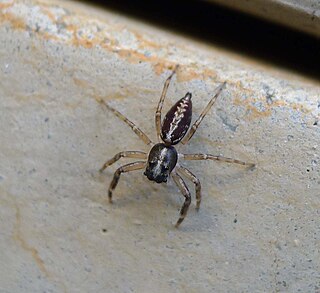
Myrmarachne is a genus of ant-mimicking jumping spiders that was first described by W. S. MacLeay in 1839. They are commonly called antmimicking spiders, but they are not the only spiders that have this attribute. The name is a combination of Ancient Greek μύρμηξ (myrmex), meaning "ant", and ἀράχνη (arachne), meaning "spider".

Canama is a genus of spiders in the jumping spider family, Salticidae. Its five described species occur from Borneo to Queensland.

Carrhotus is a genus of jumping spiders that was first described by Tamerlan Thorell in 1891. The name is derived from the Greek Κάῤῥωτος.

Chrysilla is a genus of jumping spiders that was first described by Tamerlan Thorell in 1887. Several species formerly placed here were transferred to Phintella, and vice versa. Females are 3 to 4 millimetres long, and males are 4 to 9 millimetres long. The genus is Persian, derived from the Greek Χρύσιλλα.

Cosmophasis is a genus of spiders in the family Salticidae. Some species occur in Africa, while most are found in Southeast Asia, down to Australia. Although most species more or less mimic ants, there are also colorful species that follow a different strategy.

Cytaea is a genus of spiders in the family Salticidae.

Onomastus is a genus of Asian jumping spiders that was first described by Eugène Louis Simon in 1900. It is the only genus in the subfamily Onomastinae.
Pristobaeus is a genus of jumping spiders that was first described by Eugène Louis Simon in 1902.

Rhene is a spider genus of the family Salticidae.

Telamonia is a genus of jumping spiders that was first described by Tamerlan Thorell in 1887. They are colorful spiders, with patterns that vary considerably between sexes and species. Two longitudinal stripes along the abdomen are common, and the carapace is often colored. They have a slender opisthosoma and long legs.

Thiania is a genus of jumping spiders that was first described by Carl Ludwig Koch in 1846.

Zenodorus is a genus of the jumping spiders distributed from the Moluccas to Australia, including several islands of the Pacific. It was once considered a junior synonym of Omoedus, but this was later rejected by Jerzy Prószyński in 2017. At least one species, Z. orbiculatus, specializes on hunting ants.

Euophryini is a tribe of jumping spiders. It has also been treated as the subfamily Euophryinae.
Matidia is a genus of southeast Asian sac spiders first described by Tamerlan Thorell in 1878.
Koppe is a genus of liocranid sac spiders first described by Christa L. Deeleman-Reinhold in 2001.
Oedignatha is a genus of Asian spiders first described by Tamerlan Thorell in 1881 as a genus of corrinid sac spiders, and moved to Liocranidae in 2014.

Euryattus bleekeri, known as Bleeker's jumping spider, is a species of spider in the family Salticidae. It is found from Sri Lanka to Queensland.
Medmassa is a genus of corinnid sac spiders first described by Eugène Simon in 1887 under the name "Megaera", later renamed because "Megaera" was already in use as a synonym of the reptile genus Trimeresurus.
Parabathippus is a genus of Southeast Asian jumping spiders that was first described by J. X. Zhang & Wayne Paul Maddison in 2012.













